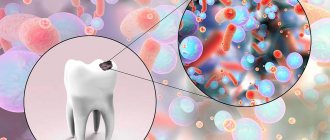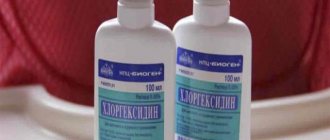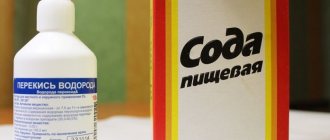Comparison of the effectiveness of Miramistin and Okomistin
The effectiveness of Miramistin is quite similar to Okomistin - this means that the ability of the drug substance to provide the maximum possible effect is similar.
For example, if the therapeutic effect of Miramistin is more pronounced, then using Okomistin even in large doses will not achieve this effect.
Also, the speed of therapy - an indicator of the speed of therapeutic action - is approximately the same for Miramistin and Okomistin. And bioavailability, that is, the amount of a drug reaching its site of action in the body, is similar. The higher the bioavailability, the less it will be lost during absorption and use by the body.
Scope of application
The significant difference between Miramistin and Hydrogen Peroxide is that the latter remedy should not be applied to the mucous membranes. It is especially dangerous to use it for gargling in a child. For the treatment of ENT logans, only Miramistin is used. In extreme cases, it can be replaced with Chlorhexidine, but under no circumstances should you irrigate the throat and nasal mucosa with Peroxide.
The antiseptic Miramistin is actively used in gynecology. Peroxide is not included in the list of drugs for the treatment of this area. A similar rule works for ophthalmology. For the purpose of treating the organs of vision, Miramistin can be used, but hydrogen peroxide cannot be used.
Comparison of the safety of Miramistin and Okomistin
The safety of a drug includes many factors.
At the same time, in Miramistin it is quite similar to Okomistin. It is important where the drug is metabolized: drugs are excreted from the body either unchanged or in the form of products of their biochemical transformations. Metabolism occurs spontaneously, but most often involves major organs such as the liver, kidneys, lungs, skin, brain and others. When assessing the metabolism of Miramistin, as well as Okomistin, we look at which organ is the metabolizing organ and how critical the effect on it is.
The risk-benefit ratio is when the prescription of a drug is undesirable, but justified under certain conditions and circumstances, with the obligatory observance of caution in use. At the same time, Miramistin does not have any risks when used, just like Okomistin.
Also, when calculating safety, it is taken into account whether only allergic reactions occur or possible dysfunction of the main organs. In other matters, as well as the reversibility of the consequences of using Miramistin and Okomistin.
Difference between Miramistin and Peroxide
A comparison of the drugs shows that their main similarity is in the form of release. Both products are sold in solution form. You do not need a prescription to purchase them. Miramistin and Peroxide are antiseptic agents. However, there is still a significant difference in the mechanism of action.
Miramistin is a transparent antiseptic solution that destroys harmful bacteria, fungi and viruses. It gently envelops the skin, lesions and mucous membranes. The effectiveness of treatment has been confirmed even with purulent wounds. The medication almost never causes an allergic reaction and has no contraindications .
A cheaper analogue works approximately the same way: Chlorhexidine. In pediatric practice, it can be used to treat wounds on the skin, and if it is necessary to irrigate the mucous membranes, Miramistin should be preferred.
Hydrogen peroxide is a colorless antiseptic solution that should be used to treat various skin lesions. The medicine is actively used to eliminate bacteria from the umbilical fossa of infants. The principle of action of the drug is the release of atomic oxygen. This process is accompanied by hissing and the formation of bubbles, due to which harmful microorganisms, dead tissue and suppuration are eliminated.
It should be noted that Hydrogen Peroxide costs significantly less than Miramistin. However, you cannot independently replace one remedy with another.
Comparison of addiction between Miramistin and Okomistin
Like safety, addiction also involves many factors that must be considered when evaluating a drug.
So, the totality of the values of such parameters as “o syndrome” in Miramistin is quite similar to the similar values in Okomistin. Withdrawal syndrome is a pathological condition that occurs after the cessation of intake of addictive or dependent substances into the body. And resistance is understood as initial immunity to a drug; in this it differs from addiction, when immunity to a drug develops over a certain period of time. The presence of resistance can only be stated if an attempt has been made to increase the dose of the drug to the maximum possible. At the same time, Miramistin has quite a small amount of “syndrome”, however, the same as Okomistin.
Miramistin
The active ingredient is benzyldimethyl ammonium chloride monohydrate . It is an antiseptic. Available in the form of solution, ointment and spray.
Miramistin is active against a large number of pathogens. The bactericidal effect is active against most gram-positive and gram-negative bacteria. It also has antifungal and antiviral effects. In addition, some pathogens of sexually transmitted diseases are sensitive to Miramistin.
Effectively prevents the growth of bacteria in wounds and burns. Also improves regeneration processes. The drug is not absorbed through the skin and mucous membranes.
Indications for use are:
- Treatment of ENT diseases as part of complex therapy.
- Treatment and prevention of inflammatory diseases in the oral cavity.
- Treatment of purulent wounds.
- Treatment of postpartum injuries, as well as treatment of inflammatory gynecological diseases.
- Treatment of superficial burns.
- Treatment of certain dermatological diseases.
- Prevention of STDs.
- Treatment of certain urological diseases.
Contraindications are:
- Children under 3 years old.
- Allergic reaction to a drug.
The drug can be used both cutaneously and for treating mucous membranes in various ways. The dosage and method of use are determined by the doctor, depending on the purpose of use.
Comparison of side effects of Miramistin and Okomistin
Side effects or adverse events are any adverse medical event that occurs in a subject after administration of a drug.
Miramistin's side effects are almost the same as Okomistin's. They both have few side effects. This implies that the frequency of their occurrence is low, that is, the indicator of how many cases of an undesirable effect of treatment are possible and registered is low. The undesirable effect on the body, the strength of influence and the toxic effect of Miramistin are similar to Okomistin: how quickly the body recovers after taking it and whether it recovers at all.
Can Miramistin® be harmful?
Many people are interested in how safe Miramistin solution is, whether the drug is dangerous or toxic for a child, whether one can be sure that the benefits of its use always outweigh the possible harm, whether this drug can have a systemic negative effect on the body, whether it kills beneficial microflora and whether it causes local side effects.
Miramistin® is an original drug, the key property of which, which determines its benefits for various infections, is its effect on pathogenic microorganisms. It fights a variety of bacteria and fungi, complex viruses and sexually transmitted infections1.
But could a situation arise in which a drug would destroy not only pathogenic microbes, but also healthy cells in our body? The results of preclinical and clinical studies of the effectiveness and safety of Miramistin, which were carried out over many years of its use in medical practice, answer the questions: is this drug always safe when used according to the instructions, can Miramistin solution be harmful, what are the side effects does it cause and have a systemic effect on the body.
When answering the question whether Miramistin solution can cause harm, experts first of all emphasize that the drug only acts locally. It is not absorbed into the bloodstream, therefore it is not harmful to the internal organs and tissues of the body, including the intestinal microflora.
Miramistin® kills pathogenic microorganisms, but does not affect healthy viable skin cells, but rather activates the restoration of damaged tissue, helps relieve inflammation and stimulates local protective reactions. Miramistin® does not cause side effects, except for very rare cases of allergic reactions and a slight burning sensation, which goes away on its own after 15–20 seconds. The only contraindication to the use of Miramistin in adults and children over 3 years of age is hypersensitivity to the active substance. Also, the product in the form of a spray is not recommended for use for irrigating the throat and tonsils for children under 3 years of age1.
Thanks to this favorable safety profile, even pregnant and lactating women can use Miramistin, and it is also prescribed to children from birth for the prevention and complex treatment of various infectious diseases of the skin and mucous membranes1.
We talk about one of them, cystitis, here.
Comparison of ease of use of Miramistin and Okomistin
This includes dose selection taking into account various conditions and frequency of doses. At the same time, it is important not to forget about the release form of the drug; it is also important to take it into account when making an assessment.
The ease of use of Miramistin is approximately the same as Okomistin. However, they are not convenient enough to use.
The drug ratings were compiled by experienced pharmacists who studied international research. The report is generated automatically.
Last update date: 2020-12-13 10:42:47
Comparative analysis
You should not use Miramistin and Hydrogen Peroxide at the same time on your own. Your doctor will dispel any doubts about the possibility of using antiseptics. After a comparative analysis, we can say:
- You can rinse your mouth with Miramistin, but not with Peroxide;
- Miramistin is more expensive, which makes this drug less accessible;
- Peroxide is recognized as a stronger contender in the fight against microbes;
- Peroxide dries out wet wounds;
- Miramistin does not stop bleeding, and Peroxide helps to clog a bleeding wound.
Which of these remedies is better can only be said taking into account the individual characteristics of the patient and the indications for the use of the antiseptic.
What to choose?
The main similarity between antiseptics is that they are both available in solution form. However, Miramistin, in addition to the solution, has the form of an ointment and a spray. They have different active components , but still belong to the same pharmacological group . However, there is a significant difference in their mechanism of action.
Miramistin is a clear antiseptic solution that foams when shaken. It is capable of destroying harmful bacteria, viruses and fungi. When applied, the skin and mucous membranes are softly enveloped. Miramistin performed well even in the presence of purulent wounds. It has virtually no side effects or contraindications. However, the obvious difference is that it can only be used by children from 3 years of age.
Hydrogen peroxide is a colorless antiseptic solution for treating wounds on the skin. It is used to treat the umbilical wound in newborns. Peroxide has no age restrictions. Therefore, Miramistin is safer for irrigating the mucous membranes of children. But when treating wounds on the skin, you should give preference to hydrogen peroxide.
There is also a significant difference that hydrogen peroxide is not safe to apply to mucous membranes, especially for children. Despite the fact that such an application is still possible.
Miramistin is actively used in gynecology. While Peroxide cannot be used in this area. A similar rule works for ophthalmic diseases.
Both drugs are used in surgical practice. It is allowed to use them simultaneously, which is not prohibited by doctors. However, for burns it is better to use Miramistin. It does not cause burning and dryness, unlike its counterpart.
Miramistin has the following advantages:
- Wide spectrum of action.
- Several dosage forms.
- Does not cause burning.
- It has virtually no contraindications or side effects.
- Capable of fighting STDs.
Hydrogen Peroxide also has positive aspects:
- Low cost.
- It can be used even for newborn children.
- Able to dry wet wounds.
- Effective in the fight against microbes.
- Able to stop bleeding.
- Medical instruments can be disinfected.
Hydrogen peroxide is produced in Russia. The cost of the solution does not exceed 30 rubles . Miramistin is also produced in Russia, but its cost is much higher and is about 300 rubles .
Conclusion
Thus, it is impossible to say unambiguously which drug is more effective. It is necessary to take into account the individual characteristics of the patient , as well as the purpose for which the use of antiseptic is required. We can definitely say that it is better to use hydrogen peroxide to treat the skin of young children. If treatment of mucous membranes is required, then Miramistin should be used. In other cases, the antiseptic is prescribed by a doctor, depending on the patient’s disease.
Medicine and healthComment
Hydrogen peroxide
The active ingredient is hydrogen peroxide . Available in solution form. Belongs to the group of antiseptic agents. Has an antiseptic effect.
Upon contact with damaged mucous membranes, active oxygen is released. Due to this, you can see the reaction in the form of the formation of foam and bubbles. The use of the product softens and separates necrotic tissue, and also eliminates blood clots and pus.
Indications for use are:
- Purulent wounds.
- Inflammation of the mucous membranes.
- Bleeding (including nasal bleeding).
- Disinfection of the oral cavity (for stomatitis, sore throat).
- Wax plugs in the ears.
Hydrogen peroxide should not be used for:
- Diseases of the liver and kidneys.
- Hypertiform dermatitis.
- Hyperthyroidism.
When wounds appear, a cotton swab is moistened with a solution of hydrogen peroxide, and then the area is treated. Can also be treated using jet irrigation.
A 3% solution is used for external use. For rinsing and treating mucous membranes, a concentration of 1-3% . 0.25% is applied to the mucous membranes . If a 3% solution , then you need to dilute it with water in a ratio of 1:11 .











